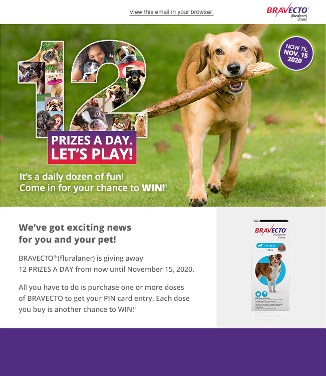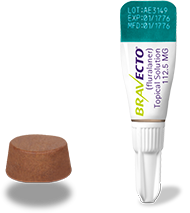
Resources for Your Practice and Clients
Digital assets to help you promote
12 PRIZES A DAY. LET’S PLAY!
Turn our latest BRAVECTO® (fluralaner) sweepstakes into a winner for your clinic.

An easy-to-send email to go directly into your clients’ inboxes
Let pet parents know all about this exciting fall sweepstakes, and how they could win 1 of 12 PRIZES A DAY with BRAVECTO.

8 social posts you can use on Facebook, Twitter and Instagram
Prepared images with text for you to post with #BravectoLetsPlay on your clinic’s social media platforms.
No items to show.
See What Your Peers and Pet Owners are Saying About the Difference of Bravecto
CONTACT US ABOUT THE 12-WEEK* DIFFERENCE
Contact us for more information about Bravecto for your hospital.
We’ll answer any questions, and help you start prescribing Bravecto for the dogs and cats in your care.


For technical assistance or to report a suspected adverse drug reaction, contact Merck Animal Health at 1-800-224-5318.
This site is intended for veterinary professionals. Vist our website for pet parents.
*BRAVECTO kills fleas and prevents flea infestation. Bravecto Chew and Bravecto Topical for Dogs kills ticks (black-legged tick, American dog tick, and brown dog tick) for 12 weeks and also kills lone star ticks for 8 weeks. Bravecto Topical for Cats kills ticks (black-legged tick) for 12 weeks and American dog ticks for 8 weeks.
IMPORTANT SAFETY INFORMATION:
BRAVECTO has not been shown to be effective for 12-weeks’ duration in puppies or kittens less than 6 months of age.
Fluralaner is a member of the isoxazoline class. This class has been associated with neurologic adverse reactions including tremors, ataxia, and seizures.
BRAVECTO Chew: The most commonly reported adverse reactions include vomiting, decreased appetite, diarrhea, lethargy, polydipsia, and flatulence.
BRAVECTO is not effective against lone star ticks beyond 8 weeks of dosing.
Seizures have been reported in dogs receiving isoxoline class drugs, even in dogs without a history of seizures.
Use with caution in dogs with a history of seizures or neurologic disorders.
BRAVECTO Topical Solution for Dogs: The most commonly reported adverse reactions include vomiting, hair loss, diarrhea, lethargy, decreased appetite, and moist dermatitis/rash. Bravecto is not effective against lone star ticks beyond 8 weeks of dosing.
For topical use only.
Avoid oral ingestion. Seizures have been reported in dogs receiving isoxoline class drugs, even in dogs without a history of seizures.
Use caution in dogs with a history of seizures or neurologic disorders.
BRAVECTO Topical Solution for Cats: The most commonly reported adverse reactions include vomiting, itching, diarrhea, hair loss, decreased appetite, lethargy, and scabs/ulcerated lesions.
BRAVECTO is not effective against American dog ticks beyond 8 weeks of dosing.
For topical use only.
Avoid oral ingestion.
The safety of BRAVECTO has not been established in breeding, pregnant and lactating cats.
Neurologic adverse reactions have been reported in cats receiving isoxazoline class drugs, even in cats without a history of neurologic disorders.
Use with caution in cats with a history of neurologic disorders.
References: 1. Bravecto Chew for Dogs [prescribing information]. Madison, NJ: Merck Animal Health; 2014. 2. Bravecto Topical Solution for Dogs [prescribing information]. Madison, NJ: Merck Animal Health; 2016. 3. Bravecto Topical Solution for Cats [prescribing information]. Madison, NJ: Merck Animal Health; 2016. 4. Freedom of Information Summary, NADA 141-426. Approved May 15, 2014. 5. Freedom of Information Summary, NADA 141-459. Approved 2016. 6. Walther FM, Allan MJ, Roepke RKA, Nuernberger MC. Safety of fluralaner chewable tablets (Bravecto™), a novel systemic antiparasitic drug, in dogs after oral administration. Parasites & Vectors (2014) 7:87. 7. Walther FM, Allan MJ, Roepke RKA, Nuernberger MC. Safety of fluralaner, a novel systemic antiparasitic drug, in MDR1(-/-) collies after oral administration. Parasites & Vectors (2014) 7:86. 8. Burgio et al. Parasites & Vectors (2016) 9:626. 9. Taenzler et al. Parasites & Vectors (2014) 7:567. 10. Wengenmayer et al. Parasites & Vectors (2014) 7:525.


